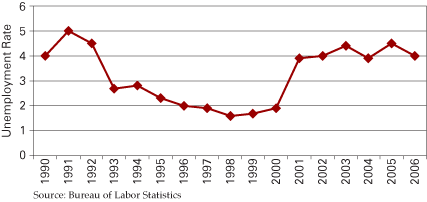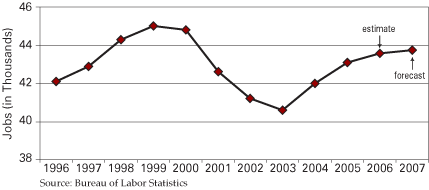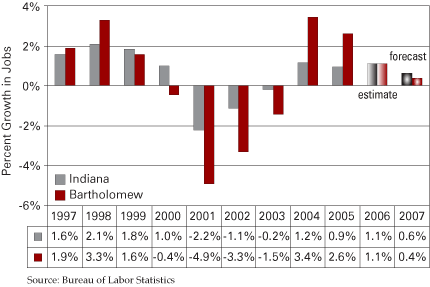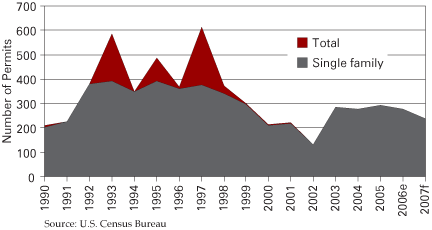Columbus
Indiana Business Research Center, Kelley School of Business, Indiana University
The Columbus Metropolitan Statistical Area (metro) includes only Bartholomew County. It is the smallest of the fourteen Indiana-based metros, with employment in September 2006 of 43,800.
Jobs
Manufacturing accounted for 35.2 percent of total nonfarm jobs in Bartholomew County in September 2006. This is far above the 16.4 percent figure for Indiana’s fourteen metros and the 9.4 percent level of the nation’s 388 metros.
As a manufacturing center, Bartholomew County is more subject to wide swings in its unemployment rate than many other areas. From a recession high of 5 percent in 1991, the percent of the labor force seeking employment declined to 1.6 percent in 1998. As the recession of the early 2000s took hold, the rate rose sharply, ranging from 3.9 percent to 4.5 percent over the past five years (see Figure 1).
Figure 1
September Unemployment Rates for Bartholomew County

Between September 1996 and 2006, the number of jobs in the Columbus metro grew by 900 or just 90 jobs per year on average. This growth is not sufficient to accommodate the annual graduation of high school seniors in the county. Jobs in the Columbus metro grew by 0.18 percent per year on average between 1996 and 2006. This growth rate ranked 333rd among the 388 metro areas of the nation, which averaged 1.35 percent; Indiana’s metro areas averaged 0.67 percent.
As seen in Figure 2, the average annual number of jobs in the Columbus metro peaked at 45,000 in 1999 before hitting a cyclical low point in 2003 of 40,600. We estimate that the 2006 annual average number of jobs will be 43,600. Our forecast for 2007 is an increase of 200 jobs for an annual average of 43,800. Thus, the metro will still be 1,200 jobs below its 1999 peak.
Figure 2
Number of Jobs in Bartholomew County

As another result of its manufacturing intensity, the Columbus metro may outperform the U.S. and Indiana economies in years of general economic expansion. However, it tends to go into slowdowns sooner and may emerge more slowly into growth than other areas. Figure 3 illustrates this behavior over the past decade. When the economy was expanding, the Columbus metro grew faster than the state, but it began to slow more than the state when growth began to lag. Furthermore, Columbus turned negative before the state and remained below the state through 2003; when the economy turned up, Columbus advanced at a faster rate.
Figure 3
Job Growth Rates

In 2006, we estimate that Columbus’ increase in jobs will equal the state’s increase of 1.1 percent but will lag the state’s rise in the year ahead as the general economy once again slows.
Housing
The slow down in the housing sector has already reached the Columbus metro, although it seems to be a decline of only 5 percent to date from last year’s levels. We may expect a decline of 15 percent in the coming year, bringing the number of new units down to the mid-230s from the high 270s estimated for this year.
Single family units dominate the Columbus market. However, as seen in Figure 4, there were a few years when large numbers of duplexes and multi-family units were built. Such construction is not likely in 2007 with the current housing market.
Figure 4
Columbus MSA Building Permits

Labor Market and Population
In the past decade, the labor force of Bartholomew County has declined by 2,100 people—from 39,900 to 37,800. Some may have retired; others may have chosen to leave and not re-enter the labor market in order to stay home to attend to family needs. This decline in the labor force has kept the unemployment rate low even though the number of employed persons has also dropped by 2,800.
These changes were occurring while Bartholomew County was realizing a natural increase (births exceeding deaths) of 4,000 persons and net in-migration of 860 persons. Hence, the decrease in the size of the labor force and in the number of persons employed is contrary to our expectations of a community with a growing population.
Summary
In light of the moderate growth anticipated for the national and Indiana economies, the Columbus metro is not likely to see much of an increase in jobs over the next year. Although housing will not be anywhere near its highs of several years ago, the downturn will not be severe.
The development pattern of the Columbus metro over the past decade shows an economy demonstrating little growth. This weakness might be perceived as a bigger problem in the county, except that much of the job decrease has been felt by people commuting into the county from elsewhere. In 1997, those individuals accounted for 13,100 of the workers in Bartholomew County; by 2004, the number was down to 11,800.
Strengthening the attractiveness of Columbus as a place to live and shop has long been a part of the community’s objectives. It would seem that keeping that goal strong remains a good strategy for the future.
Notes
- September 2006 figures are preliminary and subject to revision. Experience shows those revisions are upward, but generally by slight amounts.
- The number of residents who are employed is not equal to the number of jobs in the county. Residents may work outside the county and persons living in other counties may commute into Bartholomew. In addition, some jobs are part-time and a given person may hold more than one job.
Also in this Issue…
- Outlook for 2007
- The International Economy
- The U.S. Economy
- Financial Forecast
- Housing
- Indiana Agriculture
- Indiana
- Anderson and Muncie
- Bloomington
- Columbus
- Evansville
- Fort Wayne
- Gary
- Indianapolis
- Kokomo
- New Albany
- Richmond
- South Bend and Elkhart-Goshen
- Terre Haute
- Indiana Metro Economies at a Glance
- Return to Table of Contents



